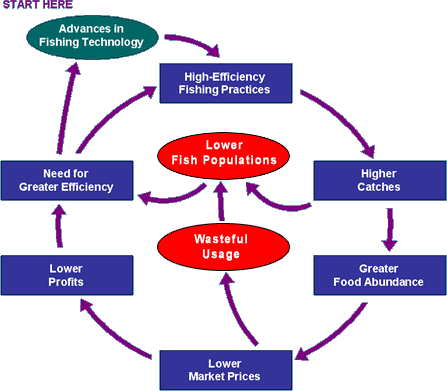
Technology
Over the past one hundred years, the fishing industry has developed and expanded to serve increasing consumer demand. Advances in fishing technology enabled this growth by catching greater quantities of fish with lower cost and less labor required. The three most lucrative fishing methods (bottom trawling, mid-range trawling, and purse seining) effectively removed entire schools of fish in very little time. Certain methods, especially bottom trawling, killed surrounding plant and animal species by destroying their sea floor habitat (Gabriel, 2005, chap. 26). Increased bycatch (nontarget species caught by commercial fishermen) also accompanied the large-scale harvesting, eliminating many populations unintentionally caught with market fish (Merriam-Webster, 2006-2007). In general, our goals in current fishing technology advancement are to decrease harmful effects on the environment while also increasing selectivity in both species and size of fish harvested. These ends focus on the restoration of fish habitats and the protection of threatened or endangered species. The means to accomplish these goals must include action from many sides at once. Governments must implement and enforce regulations to save declining fisheries. At the same time, manufacturers must introduce sustainable fishing technologies into the global market. As the new machinery becomes more common, its prices will drop and its acceptance will increase.

Figure 1. Taken from Grinning Planet
A combination of new technologies makes selectivity and habitat conservation possible, but conversion to these new methods will be costly and difficult. To ease the transition to more expensive equipment, we propose that subsidies be redirected to support sustainable fishing. Along these economic lines, tax deductions will also encourage environmentally-friendly methods. The technologies themselves include digital imaging for catch specificity, line tension sensors to indicate net content, and electronic ticklers with depth sensors for trawl nets. These and other steps will allow fisherman, even in large-scale commercial corporations, to catch fish of proper size and species without damaging the precious ocean environment. A shift of the magnitude necessary to restore the fisheries will take time and commitment from across the globe. Honed regulations from supportive governments can encourage sustainable technologies to restore declining fisheries and unify the fishing community worldwide.

